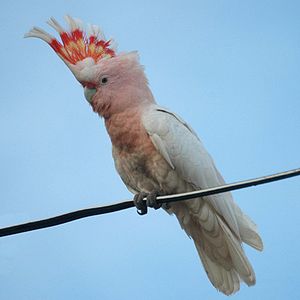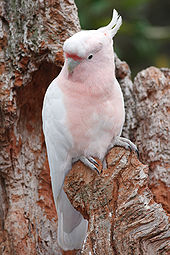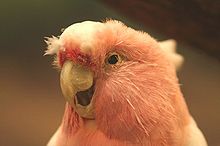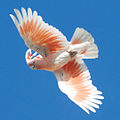- Major Mitchell's Cockatoo
-
Major Mitchell's Cockatoo 
With crest raised in Queensland, Australia Conservation status Scientific classification Kingdom: Animalia Phylum: Chordata Class: Aves Order: Psittaciformes Family: Cacatuidae Subfamily: Cacatuinae Genus: Lophochroa Species: L. leadbeateri Binomial name Lophochroa leadbeateri
(Vigors, 1831)Subspecies C. (L.). l. leadbeateri (Vigors, 1831)
C. (L.). l. mollis (Mathews, 1912)
Major Mitchell's Cockatoo range (in red) Synonyms - Plyctolophus leadbeateri
Vigors, 1831 - Lophochroa leadbeateri
The Major Mitchell's Cockatoo, Lophochroa leadbeateri, also known as Leadbeater's Cockatoo or Pink Cockatoo, is a medium-sized cockatoo restricted to arid and semi-arid inland areas of Australia. It is here placed in its own monotypic genus Lophochroa, though to include it in Cacatua as others do is not wrong as long as the corellas are also included there.[1][2]
Contents
Description
 Adult perched on a tree in Melbourne Zoo
Adult perched on a tree in Melbourne Zoo
With its soft-textured white and salmon-pink plumage and large, bright red and yellow crest, it is generally recognised as the most beautiful of all cockatoos. It is named in honour of Major Sir Thomas Mitchell, who wrote "Few birds more enliven the monotonous hues of the Australian forest than this beautiful species whose pink-coloured wings and flowing crest might have embellished the air of a more voluptuous region".
Systematics and naming
It is possibly (though not certainly) a little closer related to Cacatua than the Galah, and its lineage diverged around the time of or shortly after the acquisition of the long crest – probably the former as this crest type is not found in all Cacatua cockatoos and therefore must have been present in an early or incipient stage at the time of the divergence of the Major Mitchell's Cockatoo's ancestors. Like the Galah, this species has not lost the ability to deposit diluted pigments dyes in its body plumage, although it does not produce melanin coloration anymore, resulting in a lighter bird overall compared to the Galah. Indeed, disregarding the crest, Major Mitchell's Cockatoo looks almost like a near-leucistic version of that species (see also "External links" below). Another indication of the early divergence of this species from the "white" cockatoo lineage is the presence of features found otherwise only in corellas, such as the plaintive yodeling cry, as well as others which are unique to Major Mitchell's and the true white cockatoos, for example the large crest and rounded wing shape.[1]
The scientific name commemorates the British naturalist, Benjamin Leadbeater. In Central Australia south of Alice Springs, the Pitjantjatjara term is kakalyalya.[3]
Distribution and habitat
Unlike the Galah, Major Mitchell's Cockatoo has declined rather than increased as a result of man-made changes to the arid interior of Australia. Where Galahs readily occupy cleared and part-cleared land, Major Mitchell's Cockatoo requires extensive woodlands, particularly favouring Callitris, Allocasuarina and Eucalyptus. In contrast to other cockatoos, Major Mitchell pairs will not nest close to one another; in consequence, they cannot tolerate fragmented, partly cleared habitats, and their range is contracting.
In the Mallee region of Victoria where the Galah and Major Mitchell's Cockatoo can be found to be nesting in the same area, there has been on occasion where the two species have interbred and produced hybridised offspring[4]
Conservation Status
Australia
Major Mitchell's Cockatoo are not listed as threatened on the Environment Protection and Biodiversity Conservation Act 1999.
Victoria
- Major Mitchell's Cockatoo are listed as threatened on the Victorian Flora and Fauna Guarantee Act (1988).[5] Under this Act, an Action Statement for the recovery and future management of this species has been prepared.[6]
- On the 2007 advisory list of threatened vertebrate fauna in Victoria, this species is listed as vulnerable.[7]
Aviculture
One Major Mitchell's Cockatoo that has become quite famous is "Cookie," a beloved resident of Illinois' Brookfield Zoo near Chicago since it opened in 1934. As of 25 June 2011, Cookie is 78 years old and has retired from actively being displayed. He currently resides in the keeper's office at the Perching Bird House.
Various views and plumages
References
- ^ a b Brown, D.M. & Toft, C.A. (1999): Molecular systematics and biogeography of the cockatoos (Psittaciformes: Cacatuidae).[dead link] Auk 116(1): 141-157.
- ^ Les Christidis & Walter E Boles (2008) Systematics and Taxonomy of Australian Birds, CSIRO Publishing
- ^ Cliff Goddard (1992). Pitjantjatjara/Yankunytjatjara To English Dictionary (2 ed.). Alice Springs, Northern Territory: Institute for Aboriginal Development. p. 26. ISBN 0-949659-64-9.
- ^ Hurley. V, The State of Australias Birds 2008, Major mitchell's Cockatoo: changing threats, Birds Australia, p. 8 ISSN: 1036-7810
- ^ Department of Sustainability and Environment, Victoria
- ^ Department of Sustainability and Environment, Victoria
- ^ Victorian Department of Sustainability and Environment (2007). Advisory List of Threatened Vertebrate Fauna in Victoria - 2007. East Melbourne, Victoria: Department of Sustainability and Environment. p. 15. ISBN 978-1-74208-039-0.
- BirdLife International (2004). Cacatua leadbeateri. 2006. IUCN Red List of Threatened Species. IUCN 2006. www.iucnredlist.org. Retrieved on 11 May 2006. Database entry includes a lengthy justification of why this species is of least concern
- Flegg, Jim (2002): Photographic Field Guide: Birds of Australia. Reed New Holland, Sydney & London. ISBN 1-876334-78-9
- Fluffies.org (2006): Zazu the Major Mitchells cockatoo. Retrieved 2006-JAN-14.
- Chicago Zoological Society (2009): http://www.czs.org/czs/Cookie.aspx
External links
- World Parrot Trust Parrot Encyclopedia - Species Profiles
- BirdLife Species Factsheet
- The Rudkin Aviary: Photo of Major Mitchell's Cockatoos. Compare the right bird to this galah.
- Pc-Zoo: Major Mitchell's Cockatoo photo.
Cockatoos (family: Cacatuidae) Appearance Small NymphicusBlack Calyptorhynchus
(subgenus)Zanda
(subgenus)ProboscigerPink or grey CallocephalonEolophusLophochroaMajor Mitchell's Cockatoo (or Leadbeater's Cockatoo)White CacatuaCacatua
(subgenus)Yellow-crested Cockatoo (or Lesser Sulphur-crested Cockatoo) (supporting page: Citron-crested Cockatoo) • Sulphur-crested Cockatoo (supporting page: Eleonora Cockatoo) • Blue-eyed Cockatoo • White Cockatoo (or Umbrella Cockatoo) • Salmon-crested Cockatoo (or Moluccan Cockatoo)Licmetis
(subgenus)Long-billed Corella • Western Corella (supporting pages: Muir's Corella • Butler's Corella) • Little Corella • Tanimbar Corella (or Goffin's Cockatoo) • Solomons Cockatoo • Red-vented CockatooCategories:- IUCN Red List least concern species
- Cockatoos
- Birds kept as pets
- Birds of South Australia
- Birds of Victoria (Australia)
- Birds of Western Australia
- Cacatuinae
- Genera of birds
- Monotypic bird genera
- Animals described in 1831
- Plyctolophus leadbeateri
Wikimedia Foundation. 2010.






